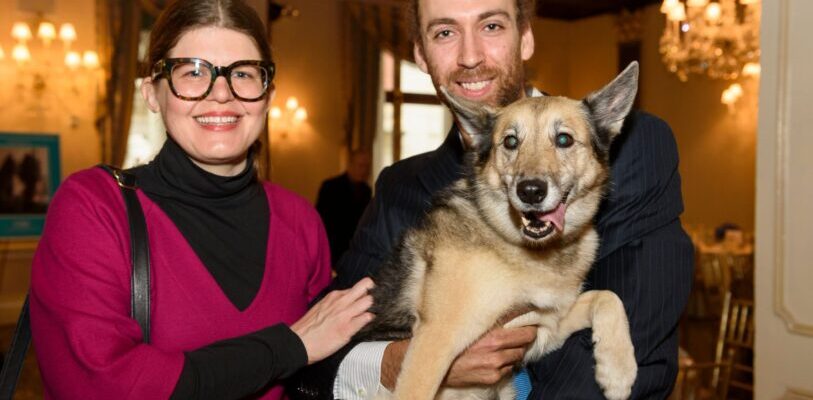Elsa

Elsa
It was a regular Saturday morning in early spring. A fresh coat of snow lay on the ground, when Charles brought his nine-year-old Shepherd mix, Elsa, to Fort Greene Park in Brooklyn to run and play. They arrived just after 7 am so they would have ample time before the 9 am leash rules went into effect.
“Elsa was energetic and a little wild,” Charles said. “She loved chasing objects, but she would only bring them part of the way back, waiting playfully until I picked them up and threw them again.”
The lacrosse ball they were playing with got lost, so Charles threw a stick for Elsa to fetch instead. The pair went back and forth a few times, but on the last throw Charles watched as Elsa caught the stick and stopped in her tracks, oddly pawing at something. Charles knew something was wrong, so he went in for a closer look.
“I started to see the blood, first covering the end of the stick and soon after, it started pouring out of her mouth,” Charles recounted. “The stick was lodged in her throat.”
Blood pooled in the freshly fallen snow as Elsa’s panic-stricken owner struggled to scoop her up with one arm and hold the wound closed with his other. Charles was standing in the middle of the dog park, covered in blood, holding an eerily calm Elsa in his arms, and muttering to himself, “What do I do?”
Other pet owners rushed over to help and together they frantically tried to hail a cab. When the first taxi stopped, the driver took one look at them and drove away. Thankfully, the next cabbie was merciful and took Charles and Elsa to The Elmer and Mamdouha Bobst Hospital of the Animal Medical Center (AMC).
Charles hurriedly paid the taxi fare and ran into the hospital, where the receptionist immediately called for assistance. A veterinarian arrived within seconds to bring Elsa to the examination room. Because of our generous donors, AMC is open around the clock to provide treatment to sick and injured pets.
“Elsa was in hypovolemic shock from severe blood loss from her mouth,” said Dr. Jennifer Prittie, Head of Emergency and Critical Care. “She was rushed to the ER and resuscitated with both fluids and red blood cells, and seemed to stabilize and recover nicely.”
With that good news, Charles was immensely relieved, pleased to see that though woozy from the drugs, Elsa was entirely intact and recovering. Erring on the side of caution, Dr. Prittie opted to keep her under observation in the intensive care unit. Charles found a comfortable spot in the waiting room to camp out, and called his wife Gretchen, who was out of town.
Two hours later, Elsa collapsed in her cage. The staff mobilized to save her. A critical care resident, Dr. Ann Zollo, carried her back to the ER, where multiple doctors and technicians worked to resuscitate her with additional fluids and red blood cells. It was not enough. Elsa needed fresh whole blood with platelets as well as clotting factors. A blood donor dog was recruited. AMC blood donors are employee-owned pets that go through an extensive screening process.
“Massive blood transfusion is not a common occurrence,” said Dr. Prittie. “As a verified veterinary trauma center, we must be able to provide this vital and limited resource without restriction.”
Elsa was in severe shock and minimally responsive. Doctors were able to find the source of immediate bleeding, and clamped the vessels off until she could be transported to the operating room, where Dr. Chick Weisse, Head of Interventional Radiology, successfully stopped the bleeding permanently. Though stable, Elsa had lost a lot of blood, and she was sedated and on a breathing apparatus. The main questions now were if she had suffered brain damage, and if she would be able to breathe on her own.
“We could tell Dr. Prittie cared deeply for patients and would give Elsa the necessary treatment,” said Charles. “She had a steady confidence that definitely made me feel like Elsa was in good hands.”
The next morning, Elsa was breathing on her own and her owners were allowed to sit and visit with her in the ICU. “It was so great to hang out with her again after thinking I never would,” Charles remembers. The day after, he was able to take her for a short walk. On the third day, Dr. Prittie met with Charles and Gretchen to update them on Elsa’s condition, share at-home care instructions and help get Elsa home; it was time for her body to rest and recover on its own.
Charles and Gretchen alternated taking days off to stay home with Elsa for the first week, and she has since recovered flawlessly. Her mouth functions as it should, and her activity level is normal. She’s mostly given up her wild games of fetch, opting for long walks instead. Dr. Prittie has even changed how she plays with her own dogs and recommends that no animals play fetch with sticks.
Elsa, who was honored this past spring as an AMC Living Legend, has returned to AMC several times, owners in tow, to visit Dr. Prittie. They ask for advice, and even drop off coffee and doughnuts. “I cannot say enough about the AMC team,” said Charles. “I could really tell how much everyone cared; they are definitely heroes to us and we will never forget what they did.”
Elsa’s successful treatment was a testament to the teamwork displayed by the AMC veterinary staff. Her case required the care and precision of emergency room doctors, surgical staff, critical care service, and blood donor dogs volunteered by AMC employees themselves. This unparalleled, all-hands-on-deck treatment structure is the keystone in AMC’s success and a primary focus of the hospital’s trauma initiative.


































